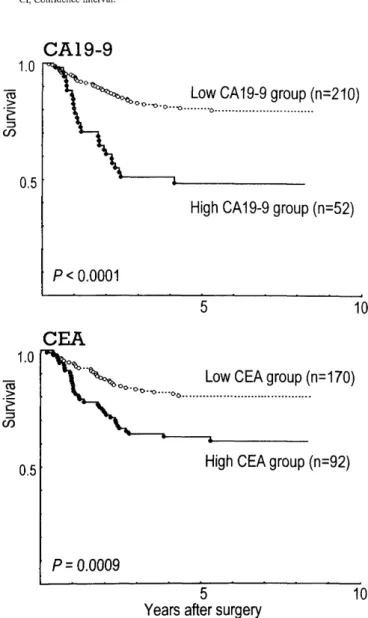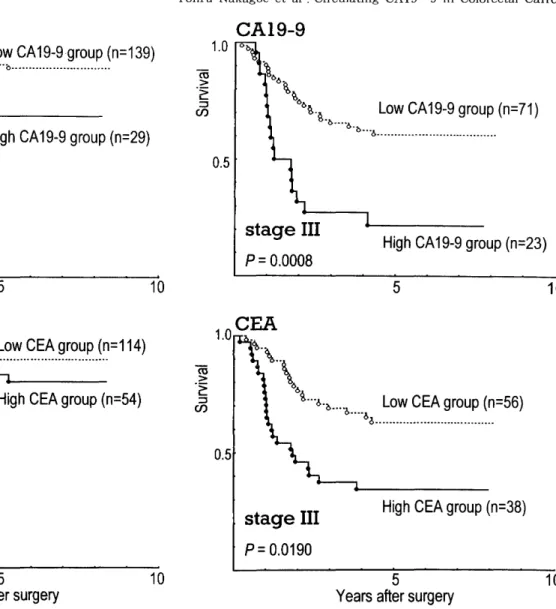Acta Med. Nagasaki 45 : 47-51
Prognostic Value of Circulating CA 19-9 in Colorectal Cancer Patients
Tohru NAKAGOE 1), Terumitsu SAWAI 1), Takashi TSUJI 1), Masaaki JIBIKI 1), Masayuki OHBATAKE 1), Atsushi NAKASHIMA 1), Hiroyuki YAMAGUCHI 1), Nobuko KUROSAKI 1), Toru YASUTAKE 1), Hiroyoshi AYABE 1), Hiroko MIYASHITA 2), Kokichi ARISAWA 3)
1) First Department of Surgery, Nagasaki University School of Medicine, Nagasaki 2) School of Allied Medical Science, Nagasaki University
3) Department of Preventive Medicine and Health Promotion, Nagasaki University School of Medicine
Aims: We examined the preoperative serum levels of sialyl Lewisa (CA19-9) and carcinoembryonic antigen (CEA) in 262 colorectal cancer patients, in order to clarify whether or not the prognostic value of CA19-9 after curative sur- gery is superior to that of CEA.
Patients and Methods: The patients were divided into two groups: low or high antigen groups (higher or lower than a selected diagnostic-based cut-off value). For evaluation of the prognostic value of CA19-9 and CEA, the disease-free interval was studied.
Results: The disease-free interval of patients with a high serum levels of CA19-9 or CEA was significantly shorter than for those patients with a low serum level of the par- ticular antigen (P<0.0001 and P=0.0009, respectively). The disease-free interval of patients with stage I/II tumors who had a high CA19-9 level was significantly shorter than in those patients with stage I/II tumors with low CA19-9 levels (P=0.0020). In contrast, the disease-free interval of pa- tients with stage I/II tumors who had a low or high CEA level did not differ. Cox s regression analysis revealed that a high serum level of CA19-9 or CEA was an independent predictor for short disease-free interval after curative sur- gery, separate from stage (Hazard ratio=2.65 or 1.68, re- spectively, versus a low serum level of each respective anti- gen) .
Conclusions: These data suggest that the preoperative serum level of CA19-9 was a stronger prognostic factor after curative surgery than CEA. Furthermore, in contrast to CEA, CA19-9 provides more prognostic information than that obtained by conventional staging methods in patients with stage I/II tumors.
Address Correspondence : Tohru Nakagoe, M.D.,
First Department of Surgery, Nagasaki University School of Medicine, 1-7-1 Sakamoto, Nagasaki 852-8501, Japan
TEL: +81-95-849-7304 FAX: +81-95-849-7306 E-mail: nakagoe@net.nagasaki-u.ac.jp
Key Words: CA19-9, Sialyl Lea; CEA; prognostic factor; colo- rectal cancer
Introduction
Carbohydrate antigen 19-9 (CA 19-9) and Carcino- ebryonic antigen (CEA) have been well recognized, and are widely used as tumor markers for colorectal caner."" The structure of CA19-9 was identified by Magnani et al. as a ganglioside-containing sialylated lacto-N-fucopentaose II (sialyl Lewisa ), structurally re- lated to the Lewisa blood-group substance.'," CA 19-9 binds to the endothelial cell-surface receptors E-selectin and P-selectin.5) Thus, cells expressing CA 19-9 adhere to endothelial cells that had been activated by some cytokine6' Such molecular function supports the idea that CA 19-9 may actually play a role in the adhesion of cancer cells to endothelial cells, resulting in hematogenous metastasis.") The increased expression of CA 19-9 in tumors, as demonstrated by immunohistochemistry, is associated with poor prognosis in colorectal cancer pa- tients after surgery.10)
Such oncologically-induced carbohydrate modifica-
tions, however, may not be limited to the tumor s pri-
mary site."' Filella et al.') reported that the preopera-
tive serum level of CA 19-9 provided more prognostic
information than could be obtained by conventional
staging methods in colorectal cancer patients. In addi-
tion, the prognostic significance of CEA was not inde-
pendent of Dukes classification.') However, to date,
CEA is the most commonly used tumor maker in pa-
tients with the colorectal cancer. It s use as an early
diagnostic index for recurrence during follow-up after
radical surgery has been well established by several
authors."-") Therefore, the aim of this study is to
clarify whether or not the prognostic value of CA19-9 is superior to that of CEA in colorectal cancer patients.
Patients and Methods
Preoperative serum levels of CA 19-9 and CEA were measured in 262 colorectal cancer patients (155 male and 107 female) who underwent attempted curative resections at Nagasaki University Hospital from January 1990 to December 1995. The median age of patients studied was 65.0 years (range, 23 - 90). Patients with more than one carcinoma of the colon (synchronous or metachronous) were excluded from this study. In the studied patients, there was no evidence of other organ malignancies, and no patients had been given preoperative treatment with anticancer drugs. Patients who died within 30 postoperative days were not in- cluded in this study.
One hundred and sixty tumors were localized in the colon and 102 tumors were localized in the rectum.
The surgically resected specimens from the 262 colo- rectal cancer patients were fixed in 10% formaldehyde and embedded in paraffin. The sections of the resected specimens were stained with hematoxylin and eosin.
The American Joint Committee on Cancer (AJCC ) Classification and Stage grouping was used to classify
the tumors.") Each tumor was histopathologically clas- sified according to its histology using the World Health Organization criteria presented by Jass and
Sobin16) : 80 tumors were classified as well-differentiated adenocarcinomas, 155 tumors as moderately differenti- ated adenocarcinomas, 20 tumors as poorly differenti- ated adenocarcinomas, and 7 tumors as mucinous car- cinomas. The 262 patients included 38 patients in stage I, 130 in stage II, and 94 in stage III.
All patients underwent standard follow-up examina- tions, including laboratory testing every 3 months.
The median length of follow-up was 1847 days (range, 72-3154 days). Of the 262 patients, 171 patients are currently alive with no evidence of recurrent disease, while 4 patients are alive with recurrent disease at the time of this writing (i.e. December 1999). Recurrences of colorectal cancer followed by death occurred in 63 patients, and 24 patients died of different diseases with no evidence of colorectal tumor.
Measurement of the serum levels of antigens
In order to detect the presence of circulating cancer markers, blood was obtained from the patients venous circulation after an overnight fast. The blood samples
were separated immediately by centrifugation and the remaining blood sera were stored at -800C until use.
The serum levels of CA19-9 and CEA were measured in the Otsuka Assay Laboratory (Tokushima, Japan) using commercially available radioimmunoassay kits:
specifically, the Centocor CA 19-9 RIA kit"' (Centocor, Malvern, PA, USA) and the CEA Roche 2 kit's) (Nippon Roche K.K., Tokyo, Japan), respectively. The data obtained were based on the simultaneous assay of these two antigens using the same set of sera. The cut-off values recommended by the manufacturers for diagnos- tic use were 37 U/ml for CA 19-9 and 2.5 ng/ml for CEA
17.18) For each antigen
, we classified the patients into two groups: a high antigen group, with a serum antigen con- centration greater than the selected cut-off value, and a low antigen group, with less than the cut-off value.
Statistical analysis
For univariate statistical analysis, the X 2 test or Fisher's exact probability test for categorical data was used. For evaluation of the prognostic value of CA 19-9 and CEA, the disease-free interval in the 262 patients was studied. The effect of each variable upon the disease-free interval was calculated according to the Kaplan-Meier method,") and differences between sur- vival curves were tested for significance using the log- rank test.20)
Multivariate analysis was performed with a Cox's proportional hazard regression model in order to as- sess the effects of different variables on patient." The serum levels of CA19-9 and CEA were compared with the stage that is generally used in colorectal cancer patient management and well-supported in the litera- ture. 15) All tests were two-tailed and a P value of less than 0.05 was considered to be significant.
Results
Comparison of stage between low antigen group and high antigen group
Of the 262 patients, the high antigen groups encom-
passed the following patients and percentages: 52
(19.9%) for CA 19-9 and 92 (35.1%) for CEA. The dis-
tribution of CA 19-9 and CEA according to the AJCC
stage grouping is shown in Table 1. The high CEA
group had a more advanced stage than the low CEA
group (P=0.0026), although there was no difference in
stage between the low CA19-9 group and the high CA19-
9 group.
Table 1. Distribution of CA19-9 and CEA according to AJCC stage grouping.
Table 2. Prognostic variables for survival in Cox s regression analysis.
No. of Carcinoma (%) No. of Carcinoma (%)
Low High Low CEA High CEA
CA19-9 CA19-9 group group
group group (n=170) (n=92)
(n=210) (n=52) P value P value
Stage 0.0965 0.0026
I 35 (16.7) 3(5.8) 34 (20.0) 4(4.4)
II 104 (49.5) 26 (50.0) 80 (47.1) 50 (54.4) III 71 (33.8) 23 (44.2) 56 (32.9) 38 (41.3)
Variable Categories Hazard ratio (95% CI*) P value
Stage I 1
II 5.07 0.67-37.99 0.1140
111 18.81 2.57-137.42 0.0038
Serum CA19-9 status Low 1
High 2.65 1.59-4.41 0.0002
Serum CEA status Low 1
High 1.68 1.02-2.78 0.0410
* CI, Confidence interval.

